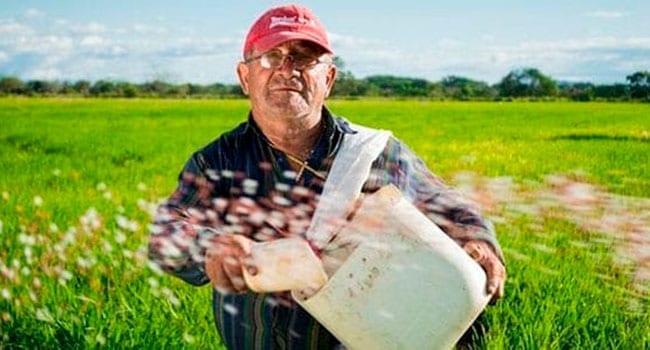 What do you think is Canada’s riskiest business? Childhood on our family farm taught me the answer to that question.
What do you think is Canada’s riskiest business? Childhood on our family farm taught me the answer to that question.
Despite years of heartbreaking disappointments, my father was a perfect example of the adage “hope springs eternal.” Each spring, he would sing happily on our tractor while seeding wheat, barley and oats. Then we hoped for enough sunny days to germinate the seeds.
If nature granted us that hope, I would tag along at dad’s side walking through fields of green waving in the winds.
Next, we’d watch each bank of clouds hoping for rain so the grain seeds would fill. But our farm was in a hail-belt. Every three years or so, those clouds would turn dark and angry, unleashing violent hailstorms that pummelled the plants and transformed that sea of green into blackened waste. Months of work, and our sole source of income for the year, gone in mere minutes.
One year, huge hailstones and high winds pounded the shingles off the barn and smashed the windows in our house. Not only did we lose the money spent planting the crop, we faced the problem of finding the funds to repair the damage.
So as in so many other cropless years, dad would get in our old farm truck and head north to haul timber used to support the roofs in coal mines.
A particularly ironic kind of heartbreak came when, after one of our best-ever crops had been cut and ready to combine, we were hit with an early snowstorm that pushed the swaths into the ground. The following winter saw an epidemic of over-gorged rodents.
If we were successful in harvesting a crop, the risks weren’t over. That often meant other farmers had good harvests, too, necessitating market rationing and leaving us with bulging grain bins and lower income.
Remarkably, my father managed to keep his sense of humour, quipping that the reason he worked off the farm was so he could afford to lose money farming.
But finally, he’d had enough of grain farming. We sold our grain farm and bought one with barns, hay fields and grazing pastures to raise livestock. Over time, we built a large herd of quality beef cattle, along with pigs and milk cows.
For my sisters and me, this meant hours of daily chores before and after school. But it eliminated most of the risks we faced on our grain farm and my father didn’t need to leave us to go trucking each winter.
But now there’s a whole new type of risk that my father’s decision to switch from grain to livestock wouldn’t have avoided. That risk was summed up by a recent Financial Post headline: “Caught in the crossfire: No other sector in our economy is getting slammed as hard as farmers in the global trade war.”
Who could have imagined that Canadian farmers would be the principal victims in the arrest of a high-ranking Chinese technology executive?
Canadian canola, the largest generator of grain crop cash receipts, has been banned by China. Now farmers face the dilemma of seeing their canola trapped in overflowing bins or selling at prices well below production costs.
Next came a ban on meat imports, eliminating a major portion of the $3.5-billion hog market and depressing prices in all markets.
Adding to that is the impact of U.S. President Donald Trump’s trade war that saw China ban American soybean imports, throwing a flood of American soybeans onto the market, collapsing prices for Canada’s third largest cash crop.
The financial hardship for Canadian farmers has been traumatic. Statistics Canada reports net farm income fell by more than half from $8.1 billion in 2017 to $3.9 billion in 2018, driving many to the edge of bankruptcy.
Farmers don’t expect Ottawa to come up with that amount of cash to bail them out, but it must be grating for them to see the Liberal government of Justin Trudeau hand dairy farmers $1.75 billion in compensation for granting American farmers access to a minuscule 3.6 per cent of the dairy market under the new trade agreement.
Is it a coincidence that meat and grain producers are mainly in the West, while dairy farming is dominated by election-crucial Quebec?
These recent events have dealt a serious blow to family farms already in demographic trouble. A Vanier Institute analysis shows that in 2016, more than half of farmer-operators were 55 and over, while just nine per cent were 35 and under.
One thing that hasn’t changed from my father’s time is the need to find off-farm employment, with 44 per cent engaged in off-farm work as a means of supplementing household income.
Since the 1950s, some 100,000 family farms have been absorbed into larger operations. Today, over 50 per cent of revenues come from just two per cent of farms. Now that geopolitics is added to the numerous other risks, consolidation of family farms into more risk tolerant large-scale corporate operations is likely to accelerate.
I grew up in an era when more than half the population of the Canadian Prairies lived in rural communities underpinned by family farms like ours. My hometown of Carstairs, Alta., was full of thriving, locally-owned businesses. Few of us ever travelled to the city to buy groceries, clothing, vehicles or anything else. The same could be said for agricultural towns throughout the West.
While my hometown’s proximity to a major city allowed it to escape oblivion by becoming a bedroom community, many of the 500 Prairie towns and villages are becoming relics of the past with formerly bustling main streets lined with boarded-up businesses, inhabited by aging retirees who carry the memories of a bygone era.
Farm consolidation will mean a more efficient and financially resilient agricultural sector. But it also means the demise of the unique Prairie culture that produced generations possessing a sound work ethic and resilience to adversity. And true community values that are becoming all too rare.
Gwyn Morgan is a retired Canadian business leader and a Member of the Order of Canada.
Gwyn is a Troy Media Thought Leader. Why aren’t you?
The views, opinions and positions expressed by columnists and contributors are the author’s alone. They do not inherently or expressly reflect the views, opinions and/or positions of our publication.


